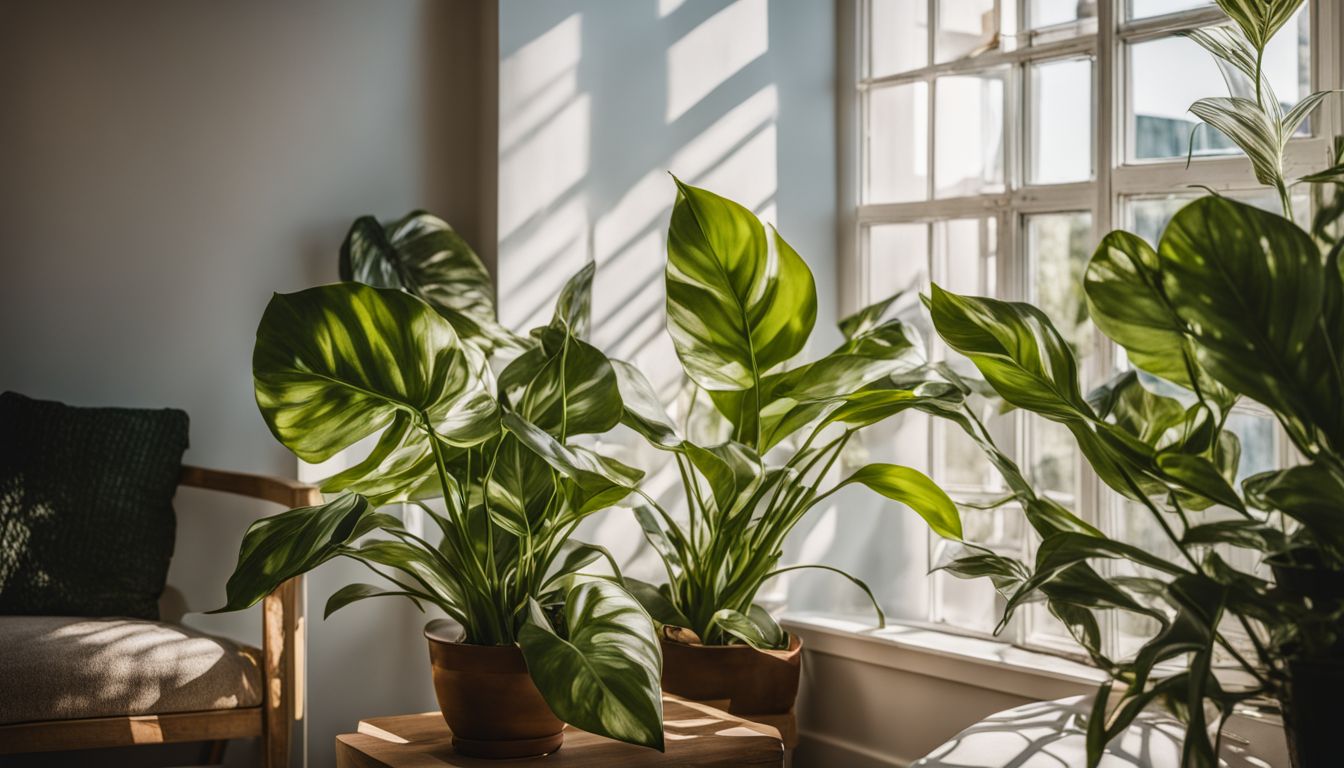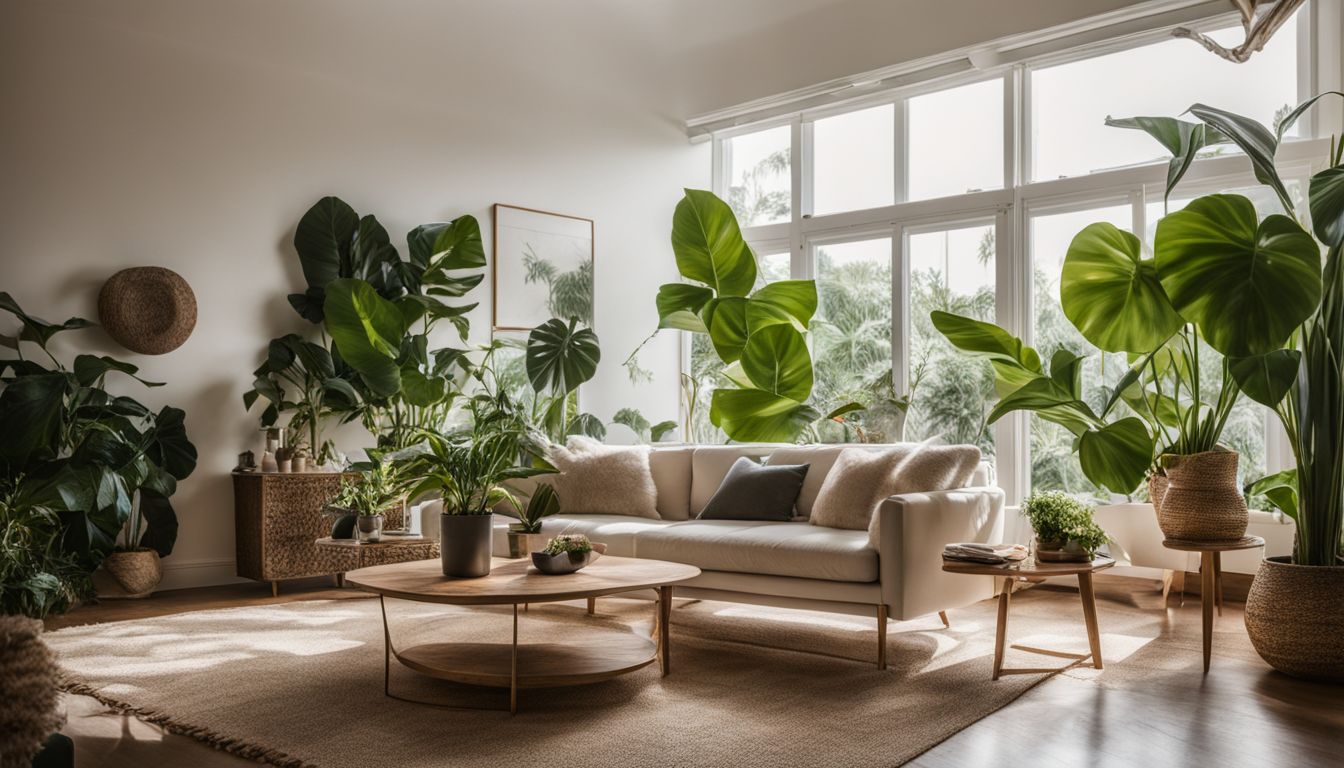Let’s explore the Full Size Philodendron Birkin, a houseplant that loves bright places but not direct sun. Think of it as a slow-growing friend with green leaves that have cool white stripes.
This plant needs to be handled just right – not too wet or too dry, and never too cold or hot! It likes being comfy between 65°F and 85°F with air that’s sort of like a warm misty morning.
People really enjoy having this plant around because it can get up to 3 feet tall and live for many years. When it gets big enough, which might take quite some time – like up to ten years – it even shows off flowers! To keep your Berkin happy you should feed the soil every few weeks when it’s growing new leaves.
Having troubles with bugs or sick leaves? Inspect your Birkin often so you can fix problems before they get bad. Just remember: watch out for too much water – this plant won’t swim well!
Caring for these plants can help your home feel alive, and if you do it right, they’ll stand tall and strong in their pots. Let’s grow our Philodendron Birkins together!
Key Takeaways
- Give your Philodendron Birkin bright, indirect sunlight for 8 to 12 hours a day and turn the pot every few weeks so all sides get light.
- Water it once a week when the top inch of soil is dry but don’t overwater since this can harm its roots.
- Use well-draining, nutrient-rich soil and feed your plant with water-soluble fertilizer every 2 to 4 weeks during growing season.
- Keep your Philodendron Birkin in a place where it’s warm (65 to 85°F) and humid (40 – 70%) to make it grow better.
- When roots fill up the pot, move your plant into a bigger one with drainage holes, and prune long stems to help the plant get bushier.
Understanding Philodendron Birkin’s Unique Traits

The Philodendron Birkin is known for its striking foliage, featuring dark green leaves with creamy white streaks. This houseplant exhibits unique growth patterns and requires specific care to thrive indoors.
Foliage Characteristics
Philodendron Birkin’s leaves are something special. They have long, oval shapes and show off beautiful creamy white streaks against a dark green background. This variegated foliage makes each leaf look like it was carefully painted with stripes.
The plant keeps its leaves all year round since it is an evergreen perennial. What really sets these leaves apart is their unique pattern, which comes from a mutation. This means that no two Birkin philodendrons will have the exact same marks on their leaves – each one is as unique as a fingerprint!
Care for these plants right, and you’ll see their full beauty shine through in your indoor garden. Each new leaf brings its own surprise, adding more of those eye-catching white pinstripes to your collection of houseplants.
Growth Patterns
I love watching my Philodendron Birkin grow. It’s amazing to think it can get up to 3 feet tall, but that takes time – sometimes as long as 10 years! This plant stands tall on its own and doesn’t need a stake or anything to hold it up because it grows straight up with a strong stem.
New leaves keep popping out quickly, especially during the growing season. That means this houseplant is busy using lots of energy just to make those leaves look beautiful. It won’t flower for many years, but when it does, you’ll know your care has paid off and your Philodendron Birkin is fully grown.
To help this friend reach its full size, I make sure the potting mix is good and feed it with houseplant fertilizer regularly. Keeping up with these needs will support my Birkin’s journey from a young leafy buddy into a mature indoor tree.
Essential Care for Philodendron Birkin

When caring for Philodendron Birkin, it is essential to provide bright, indirect light, water the plant when the top inch of soil feels dry, use a well-draining potting mix with regular fertilization during the growing season, and maintain a temperature range of 65-80°F with moderate to high humidity levels.
These factors are crucial for ensuring the healthy growth and development of your Philodendron Birkin plant.
Optimal Lighting Conditions
I love seeing my Philodendron Birkin flourish. It needs just the right light to show off its beautiful leaves. Here’s how I ensure it gets the perfect amount of sunshine:
- Find a spot near a window where the sun hits softly.
- Make sure it’s a place that avoids the harsh midday rays that can burn the leaves.
- Aim for medium to bright indirect sunlight for 8 to 12 hours each day.
- Rotate your potted plant every few weeks so all sides get even light.
- If you notice any yellowing, consider shifting it away from too much direct light.
Watering Requirements
Watering the Philodendron Birkin once a week is crucial to maintain its health and flourishing.
- Check the top two inches of soil to ensure it is dry before watering.
- Avoid overwatering to prevent root rot and other issues.
- Adjust your watering routine based on your plant’s location and soil mixture.
- Water the plant thoroughly, allowing excess water to drain away, and avoid letting it sit in water.
- Ensure you water thoroughly and let the top few inches of soil dry out before adding more moisture.
- Water your Philodendron Birkin once per week throughout the year.
Soil and Fertilization Needs
After meeting the watering requirements, it’s important to cater to the specific soil and fertilization needs of Philodendron Birkin to ensure optimal growth. Here’s a detailed guide:
- Soil: Philodendron Birkin requires well-draining, nutrient-rich potting soil for healthy growth.
- Fertilization Schedule: Regular fertilization is crucial for the optimal growth of Philodendron Birkin.
- Over-fertilizing Risk: Avoid over-fertilizing as it can lead to root burn and yellowing leaves in Philodendron Birkin.
- Winter Fertilization: It’s not necessary to fertilize Philodendron Birkin during winter months when its growth slows down.
- Suitable Fertilizer: Use a water-soluble fertilizer every 2-4 weeks for Philodendron Birkin houseplants to support their growth and development.
Temperature and Humidity Preferences
After taking care of soil and fertilization needs, it’s important to understand the temperature and humidity preferences of Philodendron Birkin. Here are the essential details:
- The ideal temperature for Philodendron Birkin is between 65 to 85 degrees Fahrenheit, allowing for optimal growth and health.
- It thrives in high levels of humidity, ideally ranging from 40-70%, with the healthiest foliage observed towards the top end of this range.
- Misting the leaves of the plant is beneficial, as it increases humidity levels around the plant, replicating its natural tropical rainforest habitat.
- Regarding temperature, Philodendron Birkin prefers a range of 60°F (15°C) to 85°F (29°C), ensuring its best growth conditions.
Achieving Full Size: Mature Philodendron Birkin Care
To achieve full size with a mature Philodendron Birkin, it’s vital to provide adequate space for its roots to grow. Repot the plant into a larger container when its roots become crowded.
Ensure the new pot has drainage holes to prevent waterlogging. Regularly prune the long stems and propagate them in water or soil, promoting bushier growth. Maintain consistent watering and fertilization schedules during the growing season to support vigorous development.
As the plant matures, regularly check for signs of overcrowding or root binding by gently removing it from its pot. Prune away any circling or excess roots before repotting in fresh soil mix with added nutrients.
The optimal care practices will encourage robust growth, resulting in a healthy and flourishing Philodendron Birkin over time.
Troubleshooting Common Issues
If you encounter any pests or diseases, such as thrips or root rot, we’ll discuss effective ways to address these issues and keep your Philodendron Birkin healthy. Additionally, learn how to manage growth problems and toxicity concerns that may arise during the care of this plant.
Addressing Pests and Diseases
Dealing with pests and diseases is crucial for keeping your Philodendron Birkin healthy. Here are some tips to address common issues:
- Regularly inspect the leaves for any signs of pest infestations, such as mealy bugs, spider mites, or aphids, which can cause damage to the plant.
- Treat fungal diseases promptly by addressing leaf spots, blotches, or powdery white mess on the leaves using appropriate fungicides and adjusting watering practices to avoid moisture buildup.
- Watch out for bacterial infections that may lead to wilting or yellowing of leaves and take quick action by adjusting watering and ventilation to prevent further spread.
- Prevent potential diseases like powdery mildew and root rot by ensuring proper air circulation, avoiding overwatering, and maintaining optimal humidity levels in the plant’s environment.
- Consider using natural remedies like neem oil spray or insecticidal soap to control pests while minimizing the use of chemical pesticides that can harm the plant.
- Keep a close eye on the overall health of your Philodendron Birkin and seek professional help if any persistent issues arise despite your best efforts.
Managing Growth Problems and Toxicity Concerns
When it comes to managing growth problems and toxicity concerns in Philodendron Birkin, it’s important to be aware of potential issues that may arise. Here are some key points to keep in mind:
- Monitor the plant for signs of stunted growth, yellowing leaves, or leaf browning, as these can indicate underlying problems with nutrients or environmental conditions.
- Check for any discoloration or unusual patterns on the leaves, which could be a sign of nutrient deficiencies or toxicity from over-fertilization.
- Ensure that the plant is not experiencing stress from extreme temperature fluctuations, as this can impact its growth and overall health.
- Avoid using water that contains high levels of chlorine or fluoride, as these chemicals can cause toxicity in the plant over time.
- Consider repotting the Philodendron Birkin if it has outgrown its current container, as restricted root growth can lead to stunted development and potential nutrient imbalances.
Conclusion
In conclusion, taking care of a Philodendron Birkin is not complicated. The key points covered in this guide are practical and easy to follow. Have you considered trying these strategies for growing your own healthy and vibrant Philodendron Birkin? By following the tips provided, you can create an environment that allows your plant to thrive.
Remember, with proper care and attention, your Philodendron Birkin will bring beauty and satisfaction to your indoor or outdoor space.
For a more in-depth understanding of nurturing your Philodendron Birkin to its mature glory, explore our comprehensive guide here.
FAQs
1. What do I need to grow a full-size Philodendron Birkin?
To grow a full-size Philodendron ‘Birkin’, you need the right potting mixes with dirt, compost and worm castings, and keep it in warm conditions similar to tropical rainforests.
2. How often should I water my Philodendron Birkin?
Water your Philodendron ‘Birkin’ with rainwater or tap water when the soil feels dry. Be careful not to over-water it as this can harm the plant.
3. Can I get free plant support help by text messages for my Philodendron Birkin?
Yes, some gardening services offer free plant care tips through text messages (SMS) that can help you take care of your indoor garden including your Philodendron ‘Birkin’.
4. What is the best way to fertilize my Philodendron ‘Birkin’?
Create a good fertilizing schedule using products safe for indoor gardening; don’t use too much which could hurt the plants growing in tropical regions inside your home.
5. Is it possible to grow a new Philodendron Birkin from stem cuttings?
Absolutely! You can cut stems from an existing plant and put them into soil or water until they grow roots known as aerial roots or rooted cuttings then transfer them into pots.

